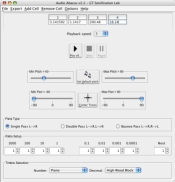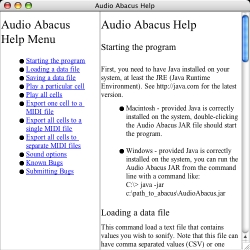
School of Psychology - Georgia Institute of Technology
Audio Abacus is a project of the Psychology Department's Sonification Lab at the Georgia Institute of Technology, overseen by Bruce Walker, PhD. Sonifications and auditory graphs are very good at providing information about trends and patterns. However, extracting the exact (or nearly exact) value of the data at a given point is a different task, and requires a different auditory interface.
One approach is to have each note of a scale represent a data value. Several approaches have been taken in this vein. Our Audio Abacus takes a new twist on this method, and has been implemented as a simple software package that allows the listener to estimate the actual values of the data, in addition to the overal trends of the data set.
The program is written in cross-platform Java, and uses JavaSound to produce MIDI output on any system that runs Java. Data can be imported from a text file or entered directly into the "cells" of the Abacus. Sound output can be exported to MIDI files for later review. The user has great control over the behaviors of the Abacus, without leading to a lot of complexity.
Users can select from the myriad of instrument that the GM MIDI specification offers, and also utilize the GM drum kit for decimal point sonification.
The Abacus allows users to set a pitch range to determine the note for each digit (0-9)
A cool feature of the Abacus is that the user can specify the pan range of a sonified number. For example, tones can be centered, or they can range from left to right, or some subset in between.
A variety of export options are available. Users can export a single cell to a MIDI file, or all of the currently loaded cells to a single MIDI file. Users can also use the Abacus in "batch mode", where every loaded cell is exported to a single MIDI file.
Consider the number "12.34":
Single - plays the numbers '1', '2', '3', '4' from left to right
Double - plays '1' and '2' from left to right, then starts again at the left and plays '3' and '4'
Bounce - plays '1' and '2' from left to right, then plays '3' and '4' from right to left.
The relative duration of up to four digits (to the left and right) of the decimal place can be set. For example, the thousands place can be made to last four times longer than the tens place, or some other combination thereof.


Included in the Abacus dowload package is a Microsoft Excel VBA Macro that allows a user to send values directly to the Audio Abacus. For installation directions and other notes, look in the ExcelMacro directory after downloading and unzipping the Audio Abacus.
Did you know you can use the MIDI files generated by the Audio Abacus to make cool ringtones for your phone? Imagine being the talk of a conference because your ringtone is Pi...or Euler's constant....to thousands of digits!!!
While we cannot possibly provide instructions on how to generate ringtones from the Abacus MIDI files (due to the variety of mobile phones and their various configurations), we can provide a few hints:
Contact: